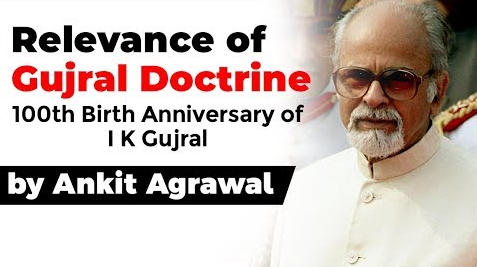Table of Contents

INTRODUCTION
- Neighbourhood first has been a key principle of India’s foreign policy for some time.
- Although, India as by far the largest and most powerful country in the subcontinent.
- At the same time, the region is divided into several independent and sovereign states.
- Hence it must have a security perspective that encompasses the entire subcontinent.
- These borders may, in different circumstances, become transmission belts for security threats such as cross-border terrorism, contraband trade or drug trafficking.
- Its borders with neighbours can also serve as “connectors” linking India with a larger landscape beyond the subcontinent.
INDIA’S VISION
- For India to aspire to a larger regional and global role, it is the more elevating vision which must prevail.
- This has been articulated by successive Indian leaders.
- But Inder Kumar Gujral, who was also a far sighted external affairs ministers, understood the over-riding challenge of the neighbourhood most clearly.
THE “GUJRAL DOCTRINE”
- It was enunciated in September 1996.
- It sought to put in place key principles which must guide relations among states of South Asia.
- No South Asian country will allow its territory to be used against the interests of another country of the region;
- None will interfere in the internal affairs of another;
- All South Asian countries must respect each other’s territorial integrity and sovereignty;
- They will settle disputes through peaceful bilateral negotiations.
- For India specifically, Gujral also declared that it “does not ask for reciprocity but gives all it can in good faith and trust”.
- These principles continue to be relevant for India’s neighbourhood policy.
TODAY’S CHALLENGES
- There is no doubt that the challenges which India must deal with in its neighbourhood have become more complex and even threatening compared to two decades ago.
- China’s footprint in the subcontinent has expanded.
- The logic of improved connectivity within the subcontinent is often trumped by heightened security concerns.
- The current slowdown in the Indian economy has meant that there is less willingness to further open the Indian market to our neighbours.
WHAT INDIA COULD DO?
- In the age of shifting geopolitics and altered balance of power India will need to restrategise its neighbourhood policy.
- There may be a need to redeploy scarce resources available from more distant development partners such as in Africa or Latin America to the subcontinent.
- Connectivity must be pursued with greater vigour.
- At the same time, security concerns must be addressed through cost effective, efficient and reliable technological measures which are in use in other parts of the world.
CONCLUSION
- India should become the transit country of choice for all our neighbours by extending national treatment on our transport network and at our ports.
- Above all, “neighbourhood first” must be anchored in sustained engagement at all levels of the political and people to people levels.






















 WhatsApp
WhatsApp